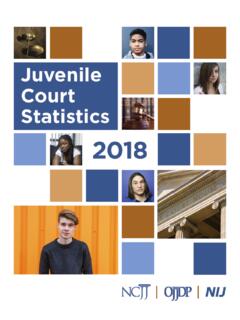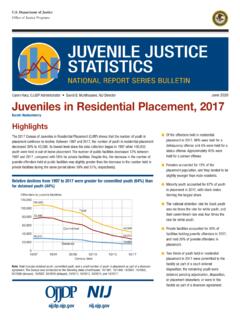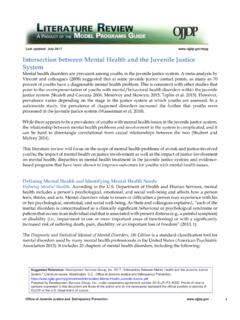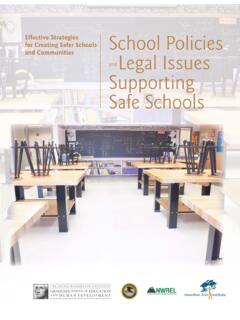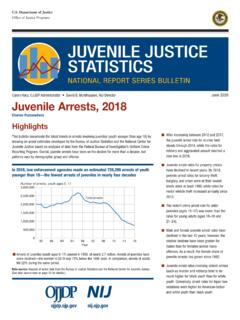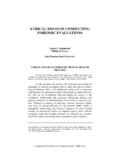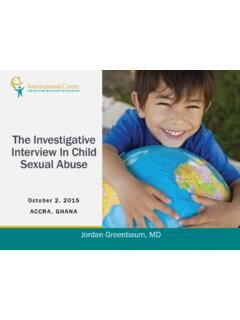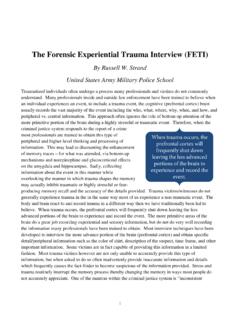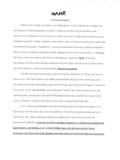Transcription of Child Forensic Interviewing: Best Practices
1 Department of JusticeOffice of Justice ProgramsOffice of Juvenile Justice and Delinquency Prevention of Juvenile Justice and Delinquency PreventionRobert L. Listenbee, AdministratorSeptember 2015 From the Administrator The Office of Juvenile Justice and Delinquency Prevention is committed to preventing the victimization of children and ensuring the well-being of all youth. In suspected abuse or maltreatment cases, law enforcement, medical, court, and other Child protection professionals Child Forensic Interviewing: Best Practices Chris Newlin, Linda Cordisco Steele, Andra Chamberlin, Jennifer Anderson, Julie Kenniston, Amy Russell, Heather Stewart, and Viola Vaughan-Eden must respond swiftly and effectively and in a manner that avoids retraumatizing the affected youth. To assist those who work in this field, the National Children s Advocacy Center convened experts from the major national Forensic interview training programs to identify best Practices in Child Forensic interviewing in cases of alleged abuse or exposure to violence.
2 The resulting discussions led to this publication, which provides guidance on topics, such as interview timing and setting, question type, rapport-building between the interviewer and the victim, interview aids as well as vicarious trauma and self-care. This bulletin represents commendable collaboration across multiple entities and is an effort to build consensus within the field. We hope that the information contained within it will aid practitioners efforts to protect children from abuse and bring those who prey upon them to justice. Robert L. Listenbee Administrator Highlights This bulletin consolidates the current knowledge of professionals from several major Forensic interview training programs on best Practices for interviewing children in cases of alleged abuse. The authors discuss the purpose of the Child Forensic interview , provide historical context, review overall considerations, and outline each stage of the interview in more detail.
3 Among the topics that the authors discuss are the following: No two children will relate their experiences in the same way or with the same level of detail and clarity. Individual characteristics, interviewer behavior, family relationships, community influences, and cultural and societal attitudes determine whether, when, and how they disclose abuse. The literature clearly explains the dangers of repeated questioning and duplicative interviews; however, some children require more time to become comfortable with the process and the interviewer. Encouraging children to give detailed responses early in the interview enhances their responses later on. Forensic interviewers should use open-ended questions and should allow for silence or hesitation without moving to more focused prompts too quickly. Although such questions may encourage greater detail, they may also elicit potentially erroneous responses if the Child feels compelled to reach beyond his or her stored memory.
4 SEPTEMBER 2015 Child Forensic Interviewing: Best Practices Chris Newlin, Linda Cordisco Steele, Andra Chamberlin, Jennifer Anderson, Julie Kenniston, Amy Russell, Heather Stewart, and Viola Vaughan-Eden During the last quarter of the 20th century, the United States began to fully recognize the incidence of Child abuse and neglect affecting our country. Increased public awareness and empirical literature have improved efforts to intervene effectively on behalf of children. One of the most significant interventions has centered on how to elicit accurate information from children regarding abuse and neglect a process commonly referred to as Forensic interviewing (Saywitz, Lyon, and Goodman, 2011). Following two decades of research and practice, professionals have gained significant insight into how to maximize children s potential to accurately convey information about their past experiences.
5 Yet, as this effort continues and practice evolves, professionals face new challenges in standardizing Forensic interviewing practice throughout the country. A relative lack of both research and practice experience challenged pioneers in the field. As such, protocols and training efforts underwent significant revisions as more research was conducted and people began gaining practice-based experience, which informed further training. Additionally, given the dearth of resources at the time, geographically diverse training programs began to develop naturally throughout the United States, emanating from frontline service providers who struggled to provide quality services themselves and who also wanted to help fellow professionals. Different case experiences, contextual perspectives, and community standards influenced these training efforts. In addition, these service providers were not directly communicating with one another about the content of their training or their theoretical approaches.
6 This further supported the existence of various approaches and the lack of standardized training language regarding Forensic interviewing. It is now widely accepted that professionals should have formal initial and ongoing Forensic interview training (National Children s Alliance [NCA], 2011). However, the field has yet to determine one standardized practice to follow throughout the country. Although national training programs are generally based on the same body of research, some differences exist. Focusing on the variations among them often obscures consistencies within the various Forensic interview models. In some cases, the veracity of the Child s statement or the performance of the Forensic interviewer has been questioned solely on the basis of the model being used. However, Forensic interviewers often receive training in multiple models and use a blended approach to best meet the needs of the Child they are interviewing (Midwest Regional Children s Advocacy Center [MRCAC], 2014).
7 Furthermore, the model being used and any subsequent adaptations to it are often rooted in jurisdictional expectations. State statutes and case law dictate aspects of interview practice, further demonstrating that no one method can always be the best choice for every Forensic interview . In 2010, representatives of several major Forensic interview training programs the American Professional Society on the Abuse of Children, the CornerHouse Interagency Child Abuse Evaluation and Training Center, the Gundersen National Child Protection Training Center, the National Children s Advocacy Center, and the National Institute of Child Health and Human Development gathered to review their programs differences and similarities. The resulting discussions led to this bulletin, which consolidates current knowledge on the generally accepted best Practices of those conducting Forensic interviews of children in cases of alleged abuse or exposure to violence.
8 Juvenile Justice Bulletin 2 Juvenile Justice Bulletin 3 SEPTEMBER 2015 This nation must remain committed to consistently putting the needs of children first. It is the authors hope that this document will become an essential part of every Forensic interview training program and will be widely used as an authoritative treatise on the implementation of best Practices in Forensic interviewing. Purpose of the Child Forensic interview The Forensic interview is one component of a comprehensive Child abuse investigation, which includes, but is not limited to, the following disciplines: law enforcement and Child protection investigators, prosecutors, Child protection attorneys, victim advocates, and medical and mental health practitioners. Although not all of the concerned disciplines may directly participate in or observe the Forensic interview , each party may benefit from the information obtained during the interview (Jones et al.)
9 , 2005). Most Child abuse investigations begin with a Forensic interview of the Child , which then provides direction for other aspects of the investigation. Although Forensic interviewers are trained to conduct quality interviews, it is important to note there is no perfect interview . For the purposes of this bulletin, and in an effort to build consensus within the field, the authors offer the following definition of a Child Forensic interview : A Forensic interview of a Child is a developmentally sensitive and legally sound method of gathering factual information regarding allegations of abuse or exposure to violence. This interview is conducted by a competently trained, neutral professional utilizing research and practice-informed techniques as part of a larger investigative process. Historical Context In the 1980s, several high-profile cases involving allegations that daycare providers had sexually abused multiple children in their care became the subject of considerable analysis because of the interview techniques that were used (Ceci and Bruck, 1995).
10 Law enforcement depended on mental health practitioners because of their ability to establish rapport with children. However, mental health practitioners often used therapeutic techniques that were later deemed inappropriate for Forensic purposes, primarily because of concerns regarding suggestibility. The courts scrutinized the interview procedures used in these early cases and found that techniques that invited make-believe or pretending were inappropriate for criminal investigations. As awareness of Child abuse grew, professionals realized that it might take special skills to interview children. Sgroi (1978) was the first medical/mental health professional to address the issue of investigative interviewing in the literature. The American Professional Society on the Abuse of Children (APSAC) wrote the first practice guidelines Psychosocial Evaluation of Suspected Sexual Abuse in Young Children (APSAC, 1990) the title of which reflects the initial focus of these interviews: mental health.

